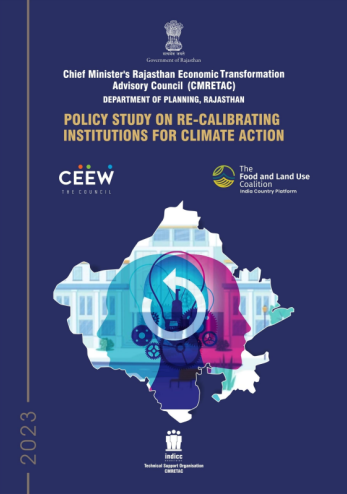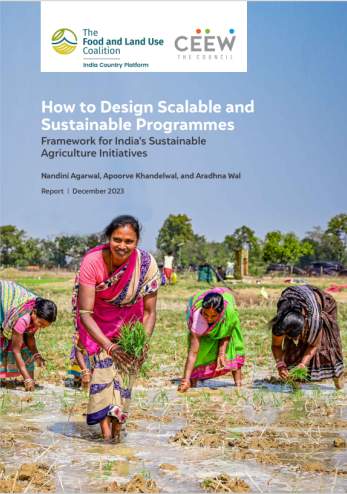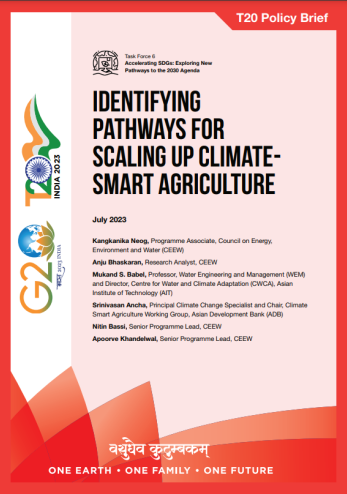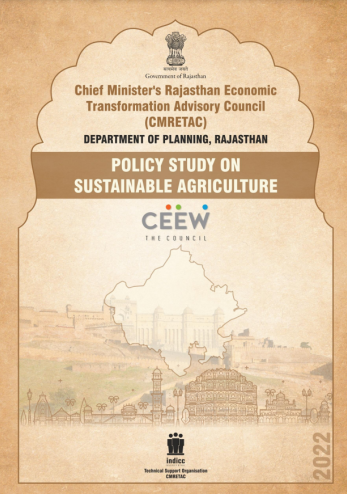



Suggested citation: Parekh, Saahil, Karan Shinghal, Nandini Agarwal, and Shuva Raha. 2023. Millet Mantra: The Culinary Centrepiece of India's G20 Presidency. New Delhi: Council on Energy, Environment and Water.
Millet Mantra: The Culinary Centerpiece of India’s G20 Presidency by CEEW and the Taj Group is a collaboration that showcases lives and livelihoods around millets. From sustainable farming of millets to trying out decadent desserts, champions of millets from different parts of India are creating a sustainable food system around this climate-resilient and nutritious grain.
The book features stories both local and global — from the villages of Odisha in eastern India to an international manifesto rallying chefs around the world to bring sustainability into culinary science. It is a compendium of the tour de force of individuals who are collectively creating a sustainable food system through millets. Interspersed with these stories are exclusive recipes of millet dishes curated by the Taj Group and served at the events held in India during its G20 presidency.
A sustainable food system should provide nutrition security for all while nurturing the environment. Millets are hardy crops, resilient to harsh climates, and offer more nutrition than rice or wheat. They are especially well-suited to the dryland regions of the world, which occupy 41 per cent of the land surface, produce 44 per cent of the crops, and provide livelihood to over 2 billion people. Mainstreaming millets once more is, therefore, a critical pathway towards improving food and nutrition security, the livelihoods of smallholder farmers, and ensuring environmental sustainability.
Millets are also integral to various cultures and cuisines across India. They have been with us for millennia, are integral to festivities, and revered both as a gift from the heavens as well as a sacred offering to the gods across the world.
The resurgence of millets on the Indian thali, spearheaded by the Indian government and businesses with both traditional and modernised recipes and preparation processes, is also being welcomed by people seeking more nourishing yet affordable meals. Twelve Indian states have policies promoting the cultivation, distribution and consumption of millets.
What we buy, how we cook, and what we eat have profound implications for the food system and its impact on the planet. The ability to make better and healthier food choices is in our hands. From appetisers to mains and desserts, the Millet Mantra presents easy to prepare millet dishes, some of which were served by the Taj group at G20 events. Learn how to make millet based soup, millet uttapams and even millet based Portuguese cakes from the comfort of your homes!
We documented the lives of a few spirited agents of change driving the adoption of millets across the food system in India and globally. We bring to you these stories of smallholder farmers, chefs, and entrepreneurs.
Seeds of change: Millet farming builds resilience of smallholder farmers
Smallholder farmer Sanjulata Mahanta’s journey from cultivating paddy to pioneering the resurgence of the finger millet in Kaunari Kala, a quaint village in the heart of Odisha’s Keonjhar district, is a tale of resilience, sustainability, and the profound impact one farmer can have on her entire community. The district has witnessed an exponential growth in millet cultivation from a mere 100 hectares in 2019 to 3,000 hectares in 2022. With growing demand, rainfall-dependent Indian farmers are embracing millets as these hardy crops can grow with as little as 350 mm of rain compared to paddy 875 mm of rainfall annually.
Flour Power: Women-led millet value chains improve local nutrition
The 500-square-foot premises of the Krishna Self-Help Group (SHG) founded by Ganga Singh in Odisha’s Keonjhar district dehusks and processes 6,000 quintals of finger millets every quarter. This is converted to nutritious food that eventually feeds children at the childcare centres. Over time, the SHG has grown into a formidable local enterprise with a monthly turnover of 2 lakhs or USD 2,400. Across India, several women-led initiatives are developing the millet value chain, steering the recovery of local crop varieties, preserving indigenous knowledge, and empowering other farmers by reducing their dependence on single-use hybrid seeds.
Soul Kitchen: Change begins in the kitchen of a home-chef turned global entrepreneur
Even though people know about the health benefits of eating millets, they often dislike them for being too dry and mealy. In India, the per capita consumption of millet fell from 32.9 kg in 1962 to just 4.2 kg in 2010, while that of wheat almost doubled from 27 kg to 52 kg during the same period. But Himanshu Kapoor, founder of C. Green Organic Future Foods, a social enterprise spreading knowledge about local food and slow cooking, disagrees. She has created a delectable assortment of puddings, pancakes and namkeen (savoury snacks), all made from millet varieties. In the last 25 years, Kapoor has conducted 600 workshops on a variety of topics from cooking with millets to developing large-scale nutrition programmes.
Into the Brew: Entrepreneurs and big businesses brew a millet transformation at scale
Thomas Zacharias’ Locavore is at the forefront of preserving local culinary traditions against the tide of globalised standardisation of diets. Nakul Bhonsle’s The Great State Aleworks experiments with brewing beers from locally sourced millets. Beyond the fringes, India’s domestic market and international export market for millets is growing. With these developments, millets are beginning to reclaim their place in India’s food system and moving from the fringe to the mainstream.
Chefs without Borders: A global network of chefs unite for sustainable culinary innovation
Chefs can catalyse change across the food system. A global network of chefs have united for sustainable culinary innovation using millets and other sustainable food. Launched in 2018, the Chefs’ Manifesto is now a global network of more than 1,250 chefs in 93 countries, facilitated by the SDG2 (Zero Hunger) Advocacy Hub. Through Action Hubs that bring together chefs, and other stakeholders, through events and workshops, collaborations with 120+ organisations, and curating sustainable dining experiences for global leaders, the Manifesto is advancing the transition to sustainable food systems.
Millets Around the World: Millets hold an important place in various cultures and cuisines around the world. These grains, which have been with us for millennia, are integral to festivities and revered both as a gift from the heavens as well as a sacred offering to the gods.
Millets in India: For over 5,000 years, millets have been a part of the Indian subcontinent’s cultural and culinary identity. Every corner of India has a unique relationship with this hardy grain.
These maps offer a glimpse into their rich history and their relationship with culture.

Policy Study on Re-calibrating Institutions for Climate Action

How to Design Scalable and Sustainable Programmes

Identifying Pathways for Scaling Up Climate-Smart Agriculture

Policy Study on Sustainable Agriculture